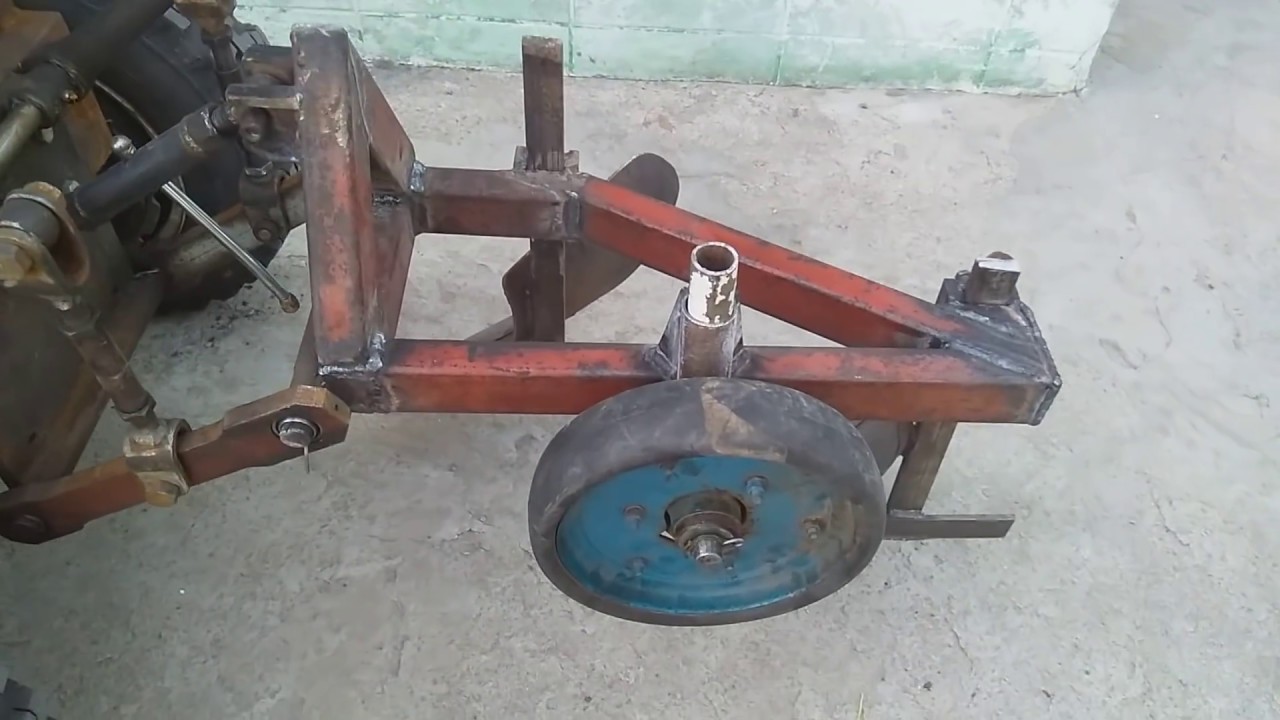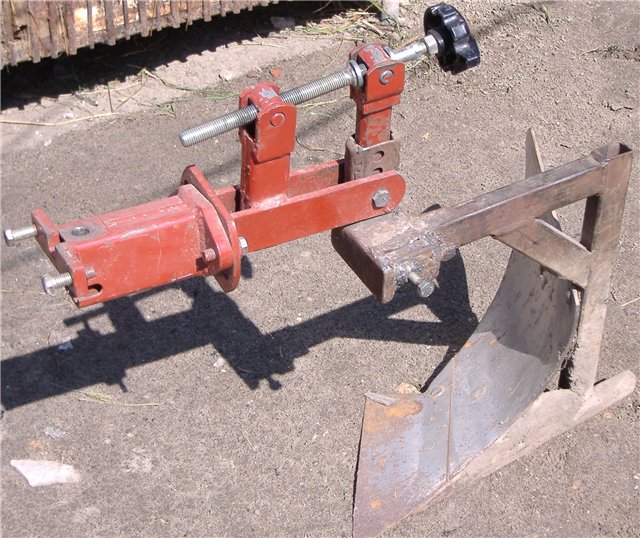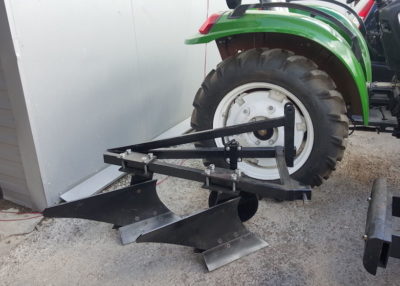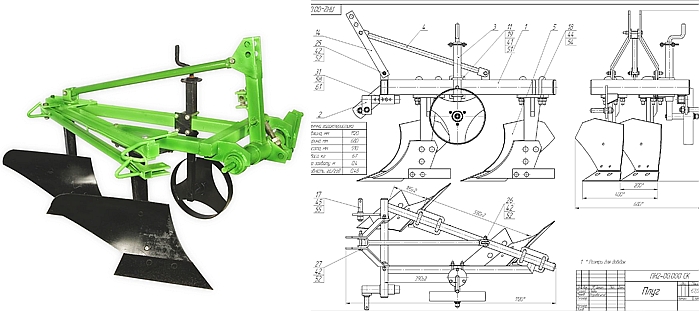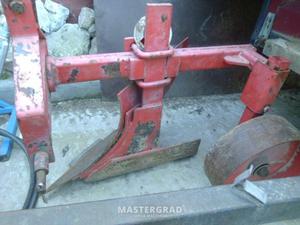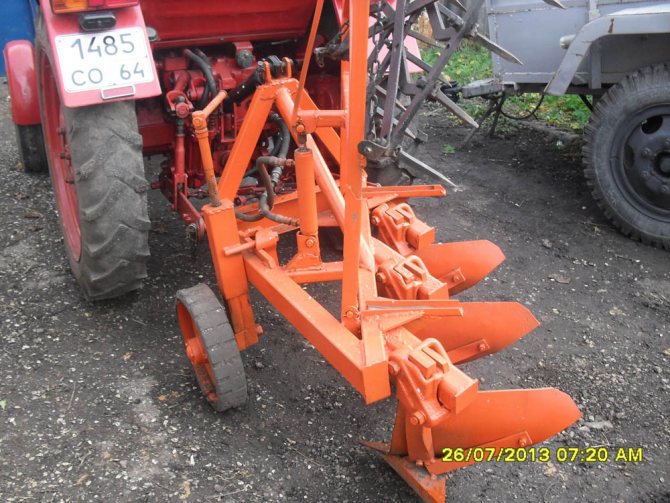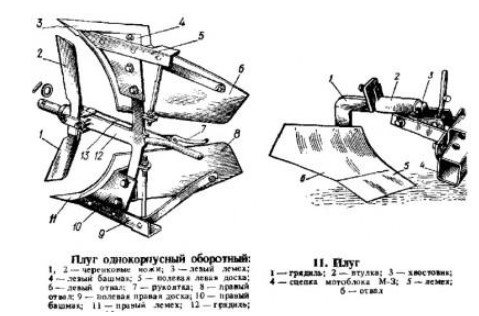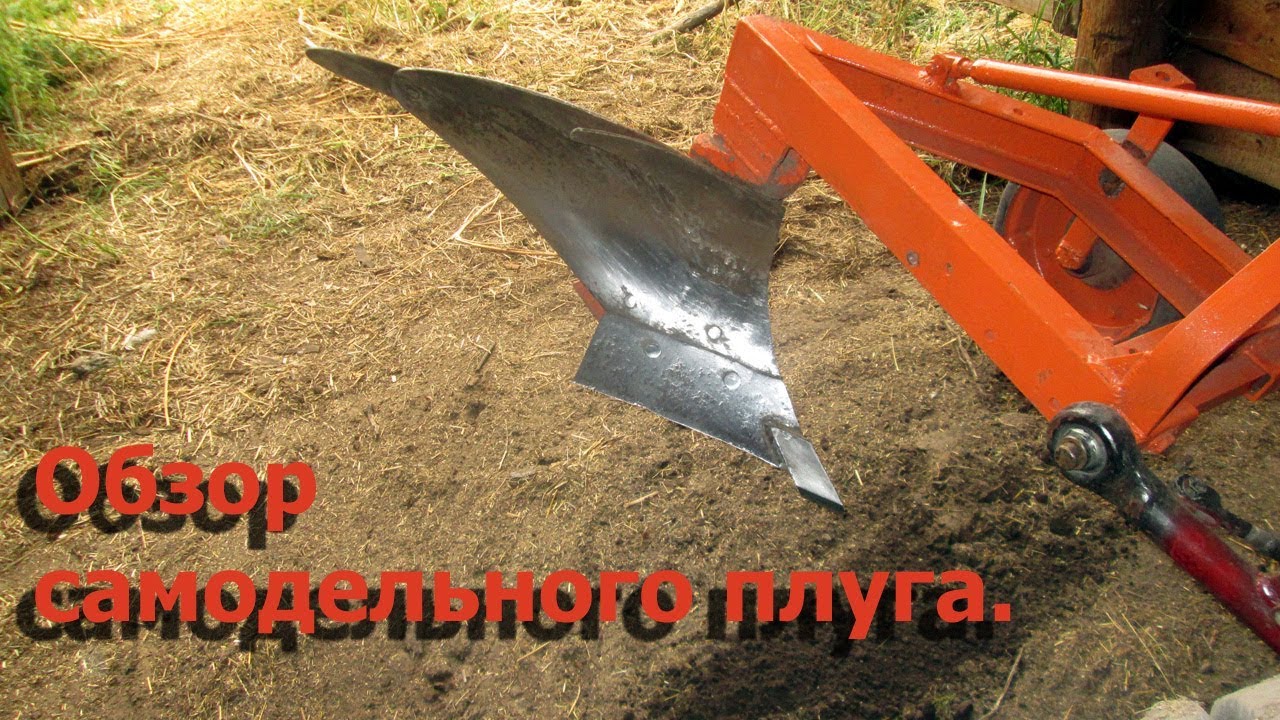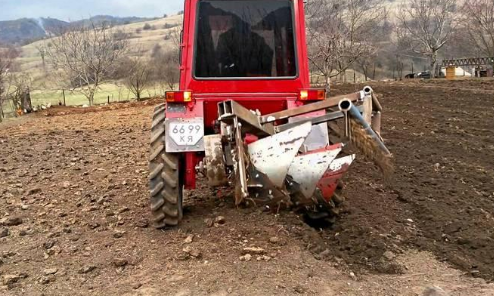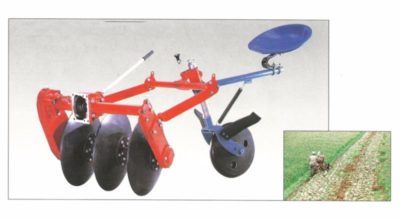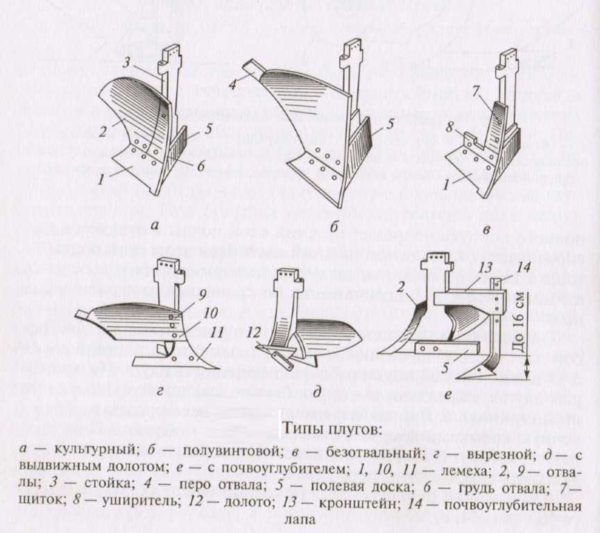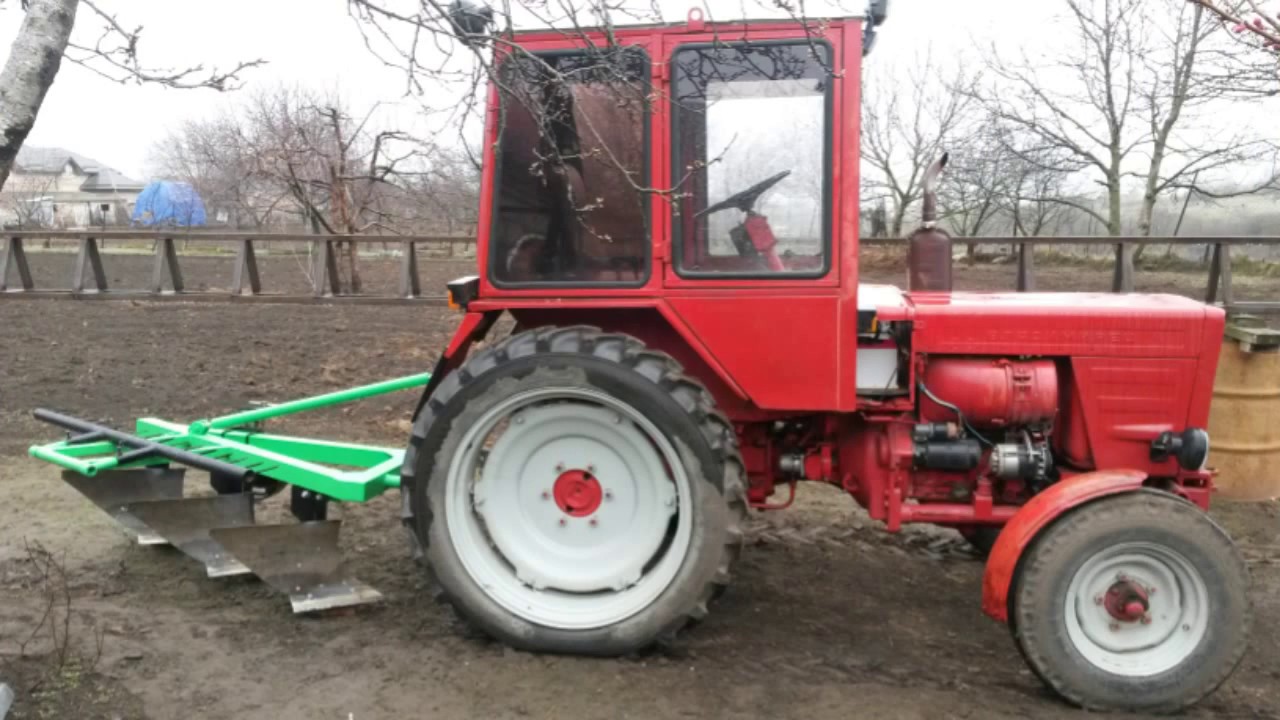How to do it?
Modern models of walk-behind tractors can be equipped with a reliable self-made plow. Varieties of this element: double-turn, reverse, double-body, rotary, or Zykov's product. There are quite a few options for manufacturing a structure. There are even options in which the body is made from a gas cylinder. It is not difficult to make a high-quality plow for motor vehicles on your own if you follow certain rules.




Rotary
The manufacture of a structure can be divided into several main stages.
A good cylinder-shaped blade is prepared. This must be done exclusively in accordance with the drawing. The part is made of alloyed metal
It is important to follow the drawn up drawing when making the structure yourself.
Expose a ploughshare. Wedges are inserted into an iron sheet (3 mm) at an angle of 45 degrees.
Connect a ploughshare with a shield on the side
Be sure to make sure that the plowshare blade is located just below the shield itself (1 cm, no more).
Attach the blade to the share.
A working half with a share is welded to a metal tube, which serves as a base, using a welding machine. On the opposite side - fasteners for motor vehicles.
When the plow is ready, an axle with wheels can be welded in its lower half.
Turning
The swivel type of the plow is rightfully recognized as one of the most functional and practical. This design is an excellent helper for plowing the land on the site, because it can cover a fairly large area. The plow is also good because you don't have to waste time with it after each approach. You just need to turn the plow and move in the opposite direction. The performance of the equipment will increase significantly. The main actions are performed in the same way as in the case of the rotary mechanism, but in this case the cutting elements must be below the runner (at least 2 cm).
Disk
It is possible to assemble a disc plow for equipment with your own hands. A similar model is assembled from parts:
- disks;
- fist;
- axles;
- bracket;
- scraper;
- leading beam;
- pens;
- screeds.

Discs for the device can be taken from an old "seeder", if there is one in the arsenal. Install these elements at an angle to increase productivity. The hiller is hung on the equipment through the coupling bracket. The T-shaped plow leash is screwed to it with bolts and a stopper. At an impressive speed, the hiller may begin to slip, so you will have to work exclusively at low speeds or with paired wheels.


Description of work on the assembly of the frame
The frame is taken as the base - the guild, the drawing can be viewed below. You can make it from a piece of metal rectangular pipe with thick walls 52x40x7 mm. A fork is made for the support wheel. To do this, two wider walls are cut from opposite sides.
The middle of the frame is marked, the transverse traverse will be welded here. In the same place, the pillars are fastened by welding. The drawbar will be attached to them. There is a hole in the front of the frame, the beginning of the fork. It should be tightly welded, otherwise, during work, the earth and debris will fall at once and clog it. From this it will quickly rust.
There is also a hole at the back of the frame, which is welded with a rivet. A round hole of 11 m is drilled in the rivet.An M10 nut is previously welded onto the rivet.

Plow shank attachment
Next, the plow stand is attached. To do this, a hole is drilled at the end of the pipe on both sides in the wide walls.It is made rectangular and has dimensions of 31x16 mm. The plow post is attached here. The side walls (narrow) are also drilled through to a diameter of 10.2 mm. The handle will be attached here with M10 bolts.
Handles are made separately. This will require a half-inch metal pipe. Can be taken from the old plumbing system. The size and curvature of the handles depends on the height of the person who will be working with the plow.
The handles need to be made as follows. The pipe is flattened at both ends with a hammer. 10.2 mm holes are drilled in them and bolted to the frame. A waterproofing tape or rubber strip is wound on top for convenience. This will make it easier to hold the element with your hand when working.
It is necessary to give the structure additional rigidity. For this, the same half-inch pipe is taken. It is welded like a cross member.
Drawbar making and wheel fastening

In order to make the drawbar, they also take an iron pipe. To do this, take a segment and cut a thread on both sides. With the help of hinges, the pipe is connected to the pins of the frame post. The connection is made through a special plug on the axle with welded nuts. The fork is also made from the same rectangular pipe, but a small section is taken and a channel is cut out of it. The half-inch sleeve should be secured to the side of the channel. A long M10 bolt is used as the pivot pin. At the end of the drawbar, a tee is mounted with a hole through?. In the tee, the thread is grinded and a piece of pipe is inserted, which is selected by diameter and length.
The wheel can be used from an old bicycle, but it will not withstand the load, so they only take rubber from it. A disc along the diameter of the wheel is cut from a sheet of getinax with a thickness of 25 mm. A hole is drilled in the center of the wheel where the nylon hub-bearing will be inserted. A groove is machined along the edge under the tire. For the axle of the wheel, a long bolt with a diameter of M10 is also used.
The most common varieties
The plow can be of different types:
- 2-body plow - it is distinguished by maneuverability and ease of use (a two-body plow can serve for a long time and provide large volumes of work);
- disk - will provide reliability and withstand heavy loads;
- monohull - very light, ideal for seasonal work;
- reversible - "active" plow, parts in which rotate - heavy, but comfortable and efficient in work;
- horse (or equestrian) - produced to work with "live" force, that is, with horses, but it is also easy to do it yourself (for example, from a bicycle frame);
- reversible plows - provide not only stable operation, but also save fuel.
As you can see, the design thought does not dry out, and the variety of plows makes it possible to cover any needs of both the terrain and the workers. In addition, if you ask yourself how to properly adjust and how to set it up, devote some time to them, then you can get the ideal option for a particular case. We add that sometimes it is advisable to use the rotary version.
Various plow designs
First you need to decide on the design of the device, because there are several different types.
Cylindrical
The cylindrical form of the plow is distinguished by excellent versatility, because it is suitable for almost any type of soil and field size. This shape makes it possible to cope well with soil crushing. In addition, making such a unit yourself will not be a problem.

Cylindrical
The only drawback of this design is shallow ground penetration.
Semi-screw
If you do not need to loosen the earth, but only need to raise the layers of soil, then the semi-screw shape of the working part of the plow will be an excellent option. It penetrates deeply into the ground, but at the same time practically does not create a loosening effect. It is usually used for heavy soil.
Lemeshny
There are also plowshares, but it is quite difficult to make them with your own hands, so they should not be considered.
How to make a plow for a walk-behind tractor and a tractor with your own hands
First, consider a plow for a walk-behind tractor or mini-tractor, which you can do with your own hands according to the drawings. For a visual analysis of the device, we recommend it free of charge.
This plow is aggregated with agricultural machinery of drag class 0.2. These can be heavy walk-behind tractors or mini tractors:
- Belarus-082;
- Belarus-112;
- Belarus-132N;
- Belarus-08K;
- KMZ-012, T-0.2 (Uralets);
- HTZ-8 (Carpathian).
Brief technical characteristics of the PN-2-20 plow:
- capture width - 0.4m;
- tillage depth - up to 25cm;
- productivity - up to 0.05 hectares / hour;
- weight of the structure - 67 kg.
The cultivation of a large plot of land is a laborious and energy-consuming process, which cannot be done without the use of technical devices. Thanks to the plow, the soil can be properly prepared for sowing, and also processed to get rid of weeds and dead wood after harvest.
The plow is attached to mechanized equipment, which, by means of a high draft force, sets the unit in motion. In the process of working with the plow, the top layer of the soil is pushed off by the plowshare, and then it simply turns over. This allows not only to loosen the soil, but also to improve its aeration. Moreover, tillage with a plow destroys up to 90% of the weeds growing on the site!
How to make this useful unit, which is necessary in every household? First you need to take care of purchasing the necessary high-quality materials. For the plow blades, you will need steel with a thickness of about 5 millimeters. The ploughshare itself should be made removable so that it can be periodically taken out and sharpened. For the body, use hardened steel, which will not hurt to treat with anti-corrosion solutions before welding.
To make a special functional plow blade, be sure to adhere to the following guidelines:
- Cut the cylindrical working surface of the blade out of the metal sheet.
- With the help of a listogib, the cut out parts are bent by 22-23 degrees, while the latter are strictly adjusted to the required shape and size.
- Please note that the size of the hollow metal pipe for the blade is about 55-59 centimeters in length. The wall thickness should not exceed 5 millimeters.
- The blade blank itself must be preheated in order to then perform matrix bending.
Directly the body for the circle can be made of a metal sheet with a thickness of at least 3-4 millimeters. A square with sides of 50 by 50 centimeters is cut out of it, to which a ploughshare, side shields and a blade must be successively attached. At the same time, make sure that the required angles between the plow components are strictly observed. The presence of gaps or inaccuracies during installation can adversely affect the durability of the unit. Having welded all the parts together, you need to clean up the seams, and it is advisable to sand the ploughshare with a blade to avoid rust.
When you master all the intricacies of making a plow for walk-behind tractors and mini tractors, you can move on to more complex tasks.
5-case reversible plow on T-150 (PLP-5-35):

This is a 3D model of a 5-body reversible trailed plow PLP-5-35 for a T-150 tractor or other tractors with a pulling class of 3 and higher. Using this 3D model of a plow for production, you do not need any drawings. The structure has been disassembled into more than 100 parts to the smallest detail. The project was created in 3D format of CAD files * .STEP. This format is supported by many CAD editors, including free FreeCAD.
Note. Working with the STEP format in FreeCAD is not very convenient. The program requires a lot of computer resources to download all the details of the device. Just opening a file on an average laptop takes about 10 minutes. If possible, use a paid professional AutoCAD program.
Drawings of the plow for the walk-behind tractor
Using the experience of craftsmen who made a plow for
do-it-yourself walk-behind tractor and left the drawings, a ploughshare should be made like this
so that it can be removed, this will make it easier to sharpen before plowing.
Alloy steel 9ХС, from which I make disks for hand
saw is considered the ideal material for the cutting edge of the plow.

Steel grade 45, hardened to hardness when quenched is suitable
HRC 50-55. If you only have ordinary steel at hand, say carbon steel St5ps,
not subject to heat treatment, then beating off the cutting edge on the anvil and
having sharpened it, it is quite suitable for tillage.
Blade for a walk-behind tractor plow
The plow blade is the part that takes the land to the side.
The first method of making a blade:
The blade should be curved.
If there is a metal bending machine or bending rollers, then give the workpiece
the desired shape is not difficult.
Required metal blank with a thickness of 3-5 mm, rollers
directed at an angle of 20-22 degrees, as shown in the drawing, and attached
the desired bend.

Second way:
Here, a blank. A pipe with a diameter of 600-650 mm can serve (namely
such a diameter will require less labor, since the pipe bend is maximal
repeat the desired bend of the future blade) and 3-5 mm thick. From cardboard, we do
template, and apply to the pipe, not forgetting about the angle of 20-22 degrees, as shown
in the drawing below.
We outline the template with a pencil or chalk, and cut out with
gas. welding, if necessary, we grind the workpiece and bring it to the desired condition.
Third way:
Probably the most difficult way to make a blade is when
the workpiece is heated and, using a matrix, is given the desired shape, which can
serve as a blade from another plow.
The material of the plow body is a steel sheet of grade
St3 - St10 with a thickness of 3 mm.
Drawing of parts of a plow for a walk-behind tractor
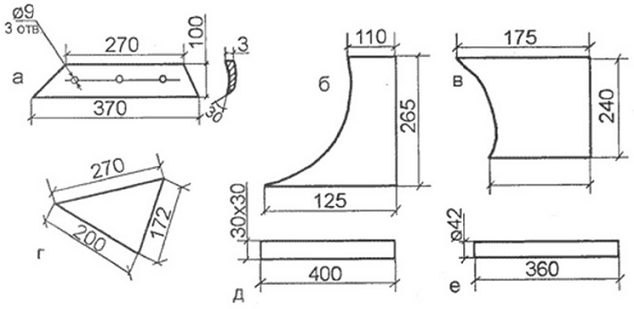
a - ploughshare from
alloy steel;
b - side plate of the rack, St3;
в - spacer plate, St3;
g - plow base plate, St3;
d - field board, corner 30x30 mm;
e - stand, pipe with a diameter of 42 mm
We advise you to first make the parts of the plow from cardboard and attach
them to each other, observing the required angles. Thus, the values of the angle α at different
parts of the plow body will be from 25 ° to 130 °, the values of the angle γ - from 42 ° to 50 °.
If a homemade cardboard model of a plow suits you in all respects, you can
go to work with metal.
When the metal parts of the plow are ready, you need to find
an additional sheet of steel 3 mm thick, 600x600 mm in size, you will need it
for assembling the plow, and a welding machine (preferably an inverter). We retreat on this sheet
from the edges 40 mm and measure the angle γ0.
Plow assembly

1 - share;
2 - side plate of the rack;
3 - additional sheet 2-3 mm
Using wedges with an angle α0 = 25 degrees and an angle γ0 = 42
degrees, a ploughshare is installed on an additional sheet and seized to the sheet by welding,
pointwise on both sides.
The side plate of the rack is connected to the ploughshare vertically so that
so that its edge goes behind the ploughshare by 4-7 mm, while the flap should be raised
higher than the share blade (that is, higher than the additional sheet) by 6-8 mm, so that
do not interfere with the share, cut the ground. The guard is also attached to the share and to the additional
sheet.
Further, it is very tightly attached to the share, without leaving a gap.
blade so that their surfaces are one piece. The angle between the top edge of the blade
and the share blade is (γmax - γ0) = 6-8 °.
Plow share attachment

- share;
- countersunk screw M8;
- blade;
- base plate;
- corner 30x30x90 mm;
- nut М8
If you find that corners and / or surfaces are not
correspond, then the blade is brought with a hammer. After adjusting the blade to
To the plowshare, it is welded from the back to the plowshare, and to the side shield. Then the side flap
welded with spacer bar and base plate, to last weld
the abutment corners for the plowshare are grabbed.
Followed by.Examine the finished plow again, and if all
clearly welded completely. Add. the sheet is separated from the body with a chisel or LNA.
All welds are sanded.
How to make a plow for a mini tractor with your own hands

know some nuances
Raising the layer of earth to a height of up to 30 cm, the body receives heavy loads, and its surface is subject to abrasive wear. Therefore, for the working parts of a homemade plow, it is advisable to use metal with a thickness of 4-6 mm.
It is advisable to make the ploughshare removable (it will be easier to sharpen before use). Of the materials, steel 9xC is best suited (discs for circulars are made) or steel 45.
Considering everything described above, you can start making a blade. It is done in three ways.
- The working part of the blade is in the form of a cylinder. If there is some kind of sheet-bending tool (for example, rollers), then much work will not be required to make a workpiece of the required shape. A metal blank of a dump (can be cut by gas electric welding or metal scissors) is fed at an inclination of 21-24 ° onto a roll or bending machine, bent and straightened according to a template.
- A pipe (wall thickness of about 6 mm) with a cross section of 50-65 cm is suitable as a dump. A template is made of cardboard, applied to the pipe, the contour is drawn with chalk and cut off by gas welding. If necessary, it is brought with a hammer.
- The most time-consuming option is when the workpiece is preheated in a forge and bent over a matrix.
The plow body is made of sheet metal (st. 3 - st. 10) at least 4 mm thick.
Experts advise to pre-make all the parts out of cardboard and glue them, keeping the required angles. If this cardboard model satisfies your requirements, then you can start making a metal plow with your own hands.
Assembly

If the angles do not match
After that, the base plate is welded onto the flap (here the thrust corners are welded for the share) and the spacer bar. This structure is carefully inspected and, in the absence of any errors, the plow is completely welded. The steel sheet, on which welding and assembly was done, is disconnected from the finished plow using a grinder or a chisel. Welding seams must be cleaned, the share and the blade are sanded with sandpaper.
To make a homemade plow self-propelled, a two-wheeled walk-behind tractor is installed on it. Having made a plow with your own hands, you can buy a strong and reliable assistant in the form of a mini tractor for little money, for cultivating the land in the field, in the garden or on your personal plot.

